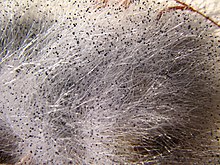Common bread mold
| Common bread mold | ||||||||||||
|---|---|---|---|---|---|---|---|---|---|---|---|---|

light microscope image of Rhizopus stolonifer |
||||||||||||
| Systematics | ||||||||||||
|
||||||||||||
| Scientific name | ||||||||||||
| Rhizopus stolonifer | ||||||||||||
| ( Honorary : Fr. ) Vuill. |
The Common bread mold ( Rhizopus stolonifer ) is a fungus and grows usually on high carbohydrate foods .
features
The haploid mycelia spread quickly and absorb nutrients. Preservatives such as calcium propionate and sodium benzoate can inhibit the growth of Rhizopus stolonifer for some time.
This yoke fungus can reproduce asexually as well as reproduce sexually; in both cases by spores. The mold grows by sticking stolons , specialized hyphae , through the surface of the food. Where the stolons touch the surface, rhizoids grow into the food. These anchor sporangiophores , each of which forms a black sporangium .
Distribution and ecology
The common bread mold is common worldwide. It colonizes substrates rich in carbohydrates such as bread, which is why it is of economic importance as a food spoiler. But it also colonizes many fruits such as papaya , plum, strawberry and sweet potato. Accordingly, it can also damage the infected plants. It rarely appears as a pathogen .
The fungus can withstand a wide range of temperature and relative humidity fluctuations .
Web links
Individual evidence
- ^ A b Murray W. Nabors: Botany. Pearson Verlag, 2007, pp. 484-485
- ↑ http://www.mycobank.org/MycoTaxo.aspx?Link=T&Rec=188377 MycoBank Rhizopus stolonifer
- ↑ John I. Pitt, Ailsa D. Hocking: Fungi and Food Spoilage. 3rd ed. Springer Verlag. 2009. p. 51f
- ↑ Varga et al., 2004. Degradation of ochratoxin A and other mycotoxins by Rhizopus isolates. International Journal of Food Microbiology Volume 99, Issue 3, April 1, 2005, pages 321-328
- ^ Nishijima, WT, Fernandez, JA, and Ebersole, p. 1990. Factors influencing development of postharvest incidence of Rhizopus soft rot of papayas. Pages 495-502 in RE Paull, Ed. Symposium on Tropical Fruit in International Trade, Honolulu, Hawaii, Acta Horticulturae 269.
